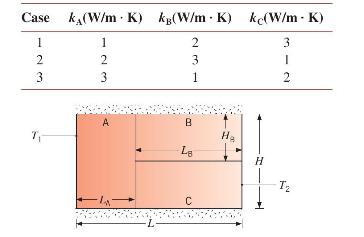Consider a composite wall of overall height (H=20) (mathrm{mm}) and thickness (L=30 mathrm{~mm}). Section A has thickness
Question:
Consider a composite wall of overall height \(H=20\) \(\mathrm{mm}\) and thickness \(L=30 \mathrm{~mm}\). Section A has thickness \(L_{\mathrm{A}}=10 \mathrm{~mm}\), and sections \(\mathrm{B}\) and \(\mathrm{C}\) each have height \(H_{\mathrm{B}}=10 \mathrm{~mm}\) and thickness \(L_{\mathrm{B}}=20 \mathrm{~mm}\). The temperatures of the left and right faces of the composite wall are \(T_{1}=50^{\circ} \mathrm{C}\) and \(T_{2}=20^{\circ} \mathrm{C}\), respectively. If the top and bottom of the wall are insulated, determine the heat rate per unit wall depth for each of the following three cases. Which case yields the largest heat rate per unit depth? Which yields the smallest heat rate per unit depth?

Step by Step Answer:

Fundamentals Of Heat And Mass Transfer
ISBN: 9781119220442
8th Edition
Authors: Theodore L. Bergman, Adrienne S. Lavine





